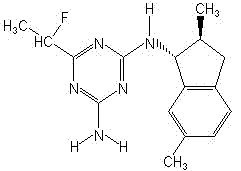|
Indaziflam
DESCRIPTION OF CHEMICAL
Chemical Name: Indaziflam; N-[(1R,2S)-2,3-dihydro-2,6-dimethyl-1H-inden-1-yl]-6-[(1RS)-1fluoroethyl]-1,3,5-triazine-2,4-diamine
Common Name: Indaziflam
Chemical Abstracts Service (CAS) Number: 950782-86-2
Pesticide Type: Herbicide
Chemical Class: Alkylazine
Structure:

Mode of Action: Indaziflam controls weeds by inhibiting cellulose biosynthesis (CB Inhibitor)
Company: Bayer Environmental Science and Bayer Advanced
USE PATTERNS AND FORMULATIONS
Application Sites: Indaziflam is a selective herbicide providing pre-emergence and post-emergence (when indaziflam is formulated with 2,4-D, dicamba, mecoprop, and penoxsulam) control of annual grasses and broadleaf weeds. Indaziflam is registered for application to residential and commercial areas (lawns, ornamentals, and hardscapes including patios, walkways, etc.), turf (parks, cemeteries, golf courses, sod farms, sports fields, and commercial lawns), field grown ornamentals and Christmas trees, commercial nursery and landscape plantings, and forestry sites.
Application Methods and Rates: Indaziflam may be applied through a variety of application methods ranging from broadcast equipment to hand held equipment. Maximum annual application rates range from 0.089 to 0.134 lbs. ai/acre/year.
PHYSICAL AND CHEMICAL PROPERTIES
Melting point/range 183 -184 oC indaziflam (pure substance)
pH (23 °C) pH = 6.5 indaziflam (pure substance)
pH = 5.1 indaziflam (technical substance)
Density 1.23 g/cm3 at 20 °C (both pure and technical substance)
Water solubility (g/L at 20 °C) pH 4: 0.0044
pH 9: 0.0028
Distilled water (pH 6.6-6.9): 0.0028
Solvent solubility (g/L at 20 °C) Acetone: 55
Acetonitrile: 7.6
Dichloromethane: 150
Dimethyl sulfoxide: >250
Ethanol: 13.0
Ethyl acetate: 47
Heptane: 0.032
Toluene: 4.3
Vapor pressure 2.5 x 10-8 PA at 20 °C or 1.875 x 10-10 mm Hg
6.8 x 10-8 PA at 25 °C or 5.1 x 10-10 mm Hg
6.9 x 10-6 PA at 50 °C or 5.2 x 10-8 mm Hg
Henry’s law constant 2.69 x 10-6 [Pa x m³/mol] at 20 °C
Dissociation constant (pKa) 3.5
Octanol/water partition coefficient Log (KOW) pH 2: 2.0
pH4, pH7 and pH9: 2.8
UV/visible absorption spectrum methanol (nm) λmax1 = 213 nm / A = 1.428
λmax2 = 268 nm / A = 0.197
λmax3 = 291 nm / A = 0.019
Summary of Acute Toxicity :
Study Type Results Toxicity Category
Acute oral - rat LD50 > 2000 mg/kg (both sexes) III
Acute dermal - rabbit LD50 > 2000 mg/kg (both sexes) III
Acute inhalation - rat LC50 > 2.3 mg/L (both sexes) IV
Acute eye irritation - rabbit Non-irritant IV
Acute dermal irritation - rabbit Non-irritant IV
Skin sensitization - guinea pig Not a sensitizer (Buehler method) N/A
|